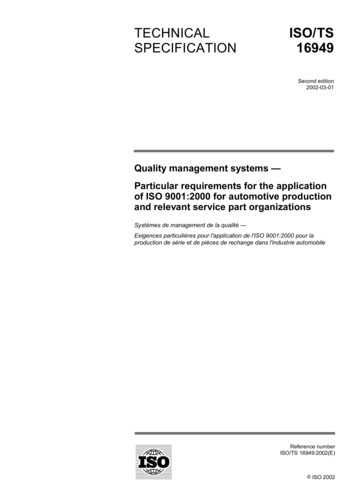
Transcription
ISO/TS16949TECHNICALSPECIFICATIONSecond edition2002-03-01Quality management systems —Particular requirements for the applicationof ISO 9001:2000 for automotive productionand relevant service part organizationsSystèmes de management de la qualité —Exigences particulières pour l'application de l'ISO 9001:2000 pour laproduction de série et de pièces de rechange dans l'industrie automobileReference numberISO/TS 16949:2002(E) ISO 2002
ISO/TS 16949:2002(E)PDF disclaimerThis PDF file may contain embedded typefaces. In accordance with Adobe's licensing policy, this file may be printed or viewed but shall notbe edited unless the typefaces which are embedded are licensed to and installed on the computer performing the editing. In downloadingthis file, parties accept therein the responsibility of not infringing Adobe's licensing policy. The ISO Central Secretariat accepts no liability inthis area.Adobe is a trademark of Adobe Systems Incorporated.Details of the software products used to create this PDF file can be found in the General Info relative to the file; the PDF-creationparameters were optimized for printing. Every care has been taken to ensure that the file is suitable for use by ISO member bodies. In theunlikely event that a problem relating to it is found, please inform the Central Secretariat at the address given below. ISO 2002All rights reserved. Unless otherwise specified, no part of this publication may be reproduced or utilized in any form or by any means, electronicor mechanical, including photocopying and microfilm, without permission in writing from either ISO at the address below or ISO's member bodyin the country of the requester.ISO copyright officeCase postale 56 CH-1211 Geneva 20Tel. 41 22 749 01 11Fax 41 22 749 09 47E-mail copyright@iso.chWeb www.iso.chPrinted in SwitzerlandThe content inside the boxed text of this document is ISO 9001:2000 text and is protected by the above copyrightstatement.The text outside the boxes has been originated by the International Automotive Task Force. Copyright for this text isheld by ANFIA, CCFA/FIEV, SMMT, VDA (see below) and the car manufacturers DaimlerChrysler, Ford MotorCompany, General Motors Corp.Neither this Technical Specification nor any extract from it may be reproduced in a retrieval system or transmitted inany form or by any means, electronic, photocopying, recording or otherwise without prior written permission beingsecured.Requests for permission to reproduce and/or translate non-boxed text should be addressed to one of the addressesbelow:International Automotive Oversight Bureau (IAOB/USA)Associazione Nazionale Fra Industrie Automobilistiche (ANFIA/Italy)Comité des Constructeurs Français d'Automobiles (CCFA/France)Fédération des Industries des Équipements pour Véhicules (FIEV/France)Society of Motor Manufacturers and Traders (SMMT/UK)Verband der Automobilindustrie - Qualitätsmanagement Center (VDA-QMC/Germany)ii ISO 2002 – All rights reserved ANFIA, CCFA/FIEV, SMMT, VDA, DaimlerChrysler, Ford Motor Company, General Motors Corp.– All rights reserved
ISO/TS 16949:2002(E)ContentsForewordPageviiRemarks for certificationviiiIntroduction0.1 General0.2 Process approach0.3 Relationship with ISO 90040.3.1 IATF Guidance to ISO/TS 16949:20000.4 Compatibility with other management systems0.5 Goal of this Technical Specificationixixixxixixixii1 Scope1.1 General1.2 Application2 Normative reference11123 Terms and definitions23.1 Terms and definitions for the automotive industry4 Quality management system4.1 General requirements4.1.1 General requirements — Supplemental4.2 Documentation requirements4.2.1 General4.2.2 Quality manual4.2.3 Control of documents4.2.3.1 Engineering specifications4.2.4 Control of records4.2.4.1 Records retention5 Management responsibility5.1 Management commitment5.1.1 Process efficiency5.2 Customer focus5.3 Quality policy5.4 Planning5.4.1 Quality objectives5.4.1.1 Quality objectives — Supplemental5.4.2 Quality management system planning5.5 Responsibility, authority and communication5.5.1 Responsibility and authority5.5.1.1 Responsibility for quality5.5.2 Management representative5.5.2.1 Customer representative5.5.3 Internal communication5.6 Management review5.6.1 General5.6.1.1 Quality management system performance ISO 2002 – All rights reserved ANFIA, CCFA/FIEV, SMMT, VDA, DaimlerChrysler, Ford Motor Company, General Motors Corp.– All rights reserved23344455566666777777888888999iii
ISO/TS 16949:2002(E)5.6.2 Review input5.6.2.1 Review input — Supplemental5.6.3 Review output99106 Resource management6.1 Provision of resources6.2 Human resources6.2.1 General101010106.2.2 Competence, awareness and training6.2.2.1 Product design skills6.2.2.2 Training6.2.2.3 Training on the job6.2.2.4 Employee motivation and empowerment6.3 Infrastructure6.3.1 Plant, facility and equipment planning6.3.2 Contingency plans6.4 Work environment6.4.1 Personnel safety to achieve product quality6.4.2 Cleanliness of premises7 Product realization7.1 Planning of product realization7.1.1 Planning of product realization — Supplemental7.1.2 Acceptance criteria7.1.3 Confidentiality7.1.4 Change control7.2 Customer-related processes7.2.1 Determination of requirements related to the product7.2.1.1 Customer-designated special characteristics7.2.2 Review of requirements related to the product7.2.2.1 Review of requirements related to the product — Supplemental7.2.2.2 Organization manufacturing feasibility7.2.3 Customer communication7.2.3.1 Customer communication — Supplemental7.3 Design and development7.3.1 Design and development planning7.3.1.1 Multidisciplinary approach7.3.2 Design and development inputs7.3.2.1 Product design input7.3.2.2 Manufacturing process design input7.3.2.3 Special characteristics7.3.3 Design and development outputs7.3.3.1 Product design outputs — Supplemental7.3.3.2 Manufacturing process design output7.3.4 Design and development review7.3.4.1 Monitoring7.3.5 Design and development 141414141415151515151616161617171717187.3.6 Design and development validation7.3.6.1 Design and development validation — Supplementaliv1818 ISO 2002 – All rights reserved ANFIA, CCFA/FIEV, SMMT, VDA, DaimlerChrysler, Ford Motor Company, General Motors Corp.– All rights reserved
ISO/TS 16949:2002(E)7.3.6.2 Prototype programme7.3.6.3 Product approval process7.3.7 Control of design and development changes7.4 Purchasing7.4.1 Purchasing process7.4.1.1 Regulatory conformity7.4.1.2 Supplier quality management system development7.4.1.3 Customer-approved sources7.4.2 Purchasing information7.4.3 Verification of purchased product7.4.3.1 Incoming product quality7.4.3.2 Supplier monitoring7.5 Production and service provision7.5.1 Control of production and service provision7.5.1.1 Control plan7.5.1.2 Work instructions7.5.1.3 Verification of job set-ups7.5.1.4 Preventive and predictive maintenance7.5.1.5 Management of production tooling7.5.1.6 Production scheduling7.5.1.7 Feedback of information from service7.5.1.8 Service agreement with customer7.5.2 Validation of processes for production and service provision7.5.2.1 Validation of processes for production and service provision — Supplemental7.5.3 Identification and traceability7.5.3.1 Identification and traceability — Supplemental7.5.4 Customer property7.5.4.1 Customer-owned production tooling7.5.5 Preservation of product7.5.5.1 Storage and inventory7.6 Control of monitoring and measuring devices7.6.1 Measurement system analysis7.6.2 Calibration/verification records7.6.3 Laboratory requirements7.6.3.1 Internal laboratory7.6.3.2 External laboratory8 Measurement, analysis and improvement8.1 General8.1.1 Identification of statistical tools8.1.2 Knowledge of basic statistical concepts8.2 Monitoring and measurement8.2.1 Customer satisfaction8.2.1.1 Customer satisfaction — Supplemental8.2.2 Internal audit8.2.2.1 Quality management system audit8.2.2.2 Manufacturing process audit8.2.2.3 Product audit ISO 2002 – All rights reserved ANFIA, CCFA/FIEV, SMMT, VDA, DaimlerChrysler, Ford Motor Company, General Motors Corp.– All rights 27v
ISO/TS 16949:2002(E)8.2.2.4 Internal audit plans8.2.2.5 Internal auditor qualification8.2.3 Monitoring and measurement of processes8.2.3.1 Monitoring and measurement of manufacturing processes8.2.4 Monitoring and measurement of product8.2.4.1 Layout inspection and functional testing8.2.4.2 Appearance items8.3 Control of nonconforming product8.3.1 Control of nonconforming product — Supplemental8.3.2 Control of reworked product8.3.3 Customer information8.3.4 Customer waiver8.4 Analysis of data8.4.1 Analysis and use of data8.5 Improvement8.5.1 Continual improvement8.5.1.1 Continual improvement of the organization8.5.1.2 Manufacturing process improvement8.5.2 Corrective action8.5.2.1 Problem solving8.5.2.2 Error-proofing8.5.2.3 Corrective action impact8.5.2.4 Rejected product test/analysis8.5.3 Preventive actionAnnex A (normative) Control plan33A.1 Phases of the control plan33A.2 Elements of the control 313131313131323232323234In this table of contents, ISO 9001:2000 headings are normal type face, IATF headings are in italics. ISO 2002 – All rights reserved ANFIA, CCFA/FIEV, SMMT, VDA, DaimlerChrysler, Ford Motor Company, General Motors Corp.– All rights reserved
ISO/TS 16949:2002(E)ForewordISO (the International Organization for Standardization) is a worldwide federation of national standards bodies (ISOmember bodies). The work of preparing International Standards is normally carried out through ISO technicalcommittees. Each member body interested in a subject for which a technical committee has been established hasthe right to be represented on that committee. International organizations, governmental and non-governmental, inliaison with ISO, also take part in the work. ISO collaborates closely with the International ElectrotechnicalCommission (IEC) on all matters of electrotechnical standardization.International Standards are drafted in accordance with the rules given in the ISO/IEC Directives, Part 3.The main task of technical committees is to prepare International Standards. Draft International Standards adoptedby the technical committees are circulated to the member bodies for voting. Publication as an International Standardrequires approval by at least 75 % of the member bodies casting a vote.In other circumstances, particularly when there is an urgent market requirement for such documents, a technicalcommittee may decide to publish other types of normative document: an ISO Publicly Available Specification (ISO/PAS) represents an agreement between technical experts in anISO working group and is accepted for publication if it is approved by more than 50 % of the members of theparent committee casting a vote; an ISO Technical Specification (ISO/TS) represents an agreement between the members of a technicalcommittee and is accepted for publication if it is approved by 2/3 of the members of the committee casting avote.An ISO/PAS or ISO/TS is reviewed after three years with a view to deciding whether it should be confirmed for afurther three years, revised to become an International Standard, or withdrawn. In the case of a confirmed ISO/PASor ISO/TS, it is reviewed again after six years at which time it has to be either transposed into an InternationalStandard or withdrawn.ISO/TS 16949:2002 was prepared by the International Automotive Task Force (IATF) and Japan AutomobileManufacturers Association, Inc. (JAMA), with support from ISO/TC 176, Quality management and quality assurance.This second edition of ISO/TS 16949 cancels and replaces the first edition (ISO/TS 16949:1999), which has beentechnically revised.Boxed text is original ISO 9001:2000 text. The sector-specific supplemental requirements are outside the boxes.In this Technical Specification, the word “shall” indicates a requirement. The word “should” indicates arecommendation. Paragraphs marked “NOTE” are for guidance in understanding or clarifying the associatedrequirement.Where the term “such as” is used, any suggestions given are for guidance only.Annex A forms a normative part of this Technical Specification. ISO 2002 – All rights reserved ANFIA, CCFA/FIEV, SMMT, VDA, DaimlerChrysler, Ford Motor Company, General Motors Corp.– All rights reservedvii
ISO/TS 16949:2002(E)Remarks for certificationThe certification to this Technical Specification, including customer-specific requirements if any, is recognized bythe customer members of IATF when achieved according to the IATF certification scheme (see the “Rules forachieving IATF recognition”).Details can be obtained at the addresses of the local oversight bodies of IATF cited below:Associazione Nazionale Fra Industrie Automobilistiche (ANFIA)e-mail: anfia@anfia.itWeb site: www.anfia.itInternational Automotive Oversight Bureau (IAOB)Web site: www.iaob.orge-mail: quality@iaob.orgFédération des Industries des Équipements pour Véhicules (FIEV)Comité des Constructeurs Français d'Automobiles (CCFA)Web site: www.iatf-france.come-mail: iatf@iatf-France.comSociety of Motor Manufacturers and Traders Ltd. (SMMT Ltd.)Web site: www.smmt.co.uke-mail: quality@smmt.co.ukVerband der Automobilindustrie Qualitätsmanagement Center (VDA-QMC)Web site: www.vda-qmc.deviiie-mail: info@vda-qmc.de ISO 2002 – All rights reserved ANFIA, CCFA/FIEV, SMMT, VDA, DaimlerChrysler, Ford Motor Company, General Motors Corp.– All rights reserved
ISO/TS 16949:2002(E)Introduction0.1 GeneralISO 9001:2000, Quality management systems — RequirementsIntroduction0.1 GeneralThe adoption of a quality management system should be a strategic decision of an organization. The design andimplementation of an organization's quality management system is influenced by varying needs
ISO/TS 16949:2002(E) . 6.2.2 Competence, awareness and training 10 6.2.2.1 Product design skills 11 6.2.2.2 Training 11 6.2.2.3 Training on the job 11 6.2.2.4 Employee motivation and empowerment 11 6.3 Infrastructure 11 6.3.1 Plant, facility and equipment planning 11 6.3.2 Contingency plans 12 6.4 Work environment 12 6.4.1 Personnel safety to achieve product quality 12 6.4.2 Cleanliness of .
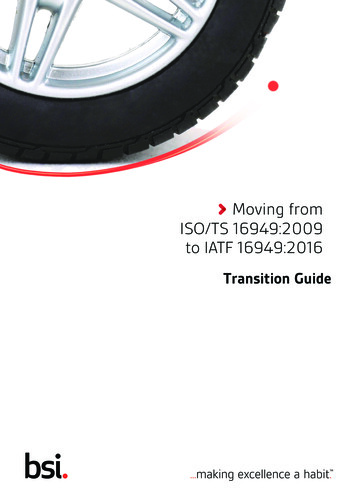
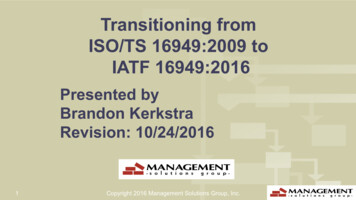

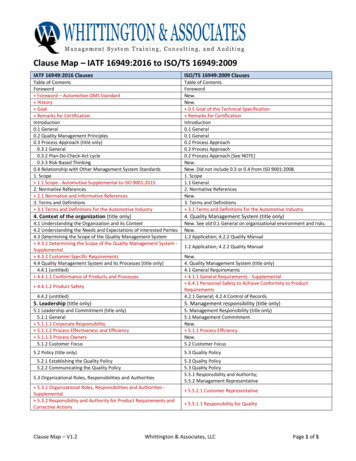
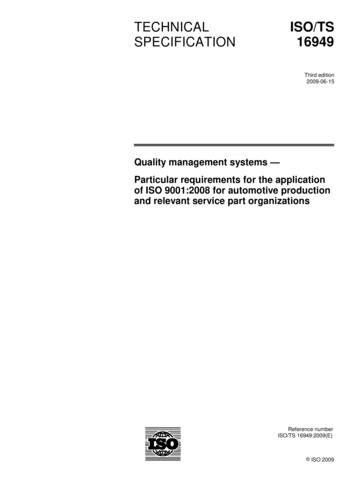

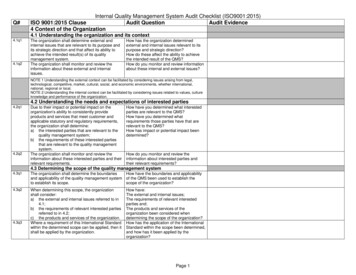
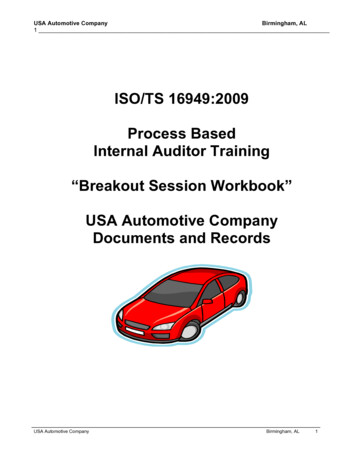
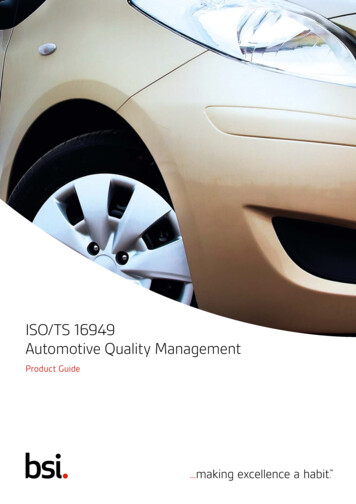
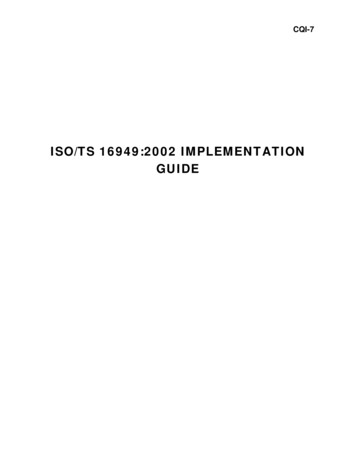
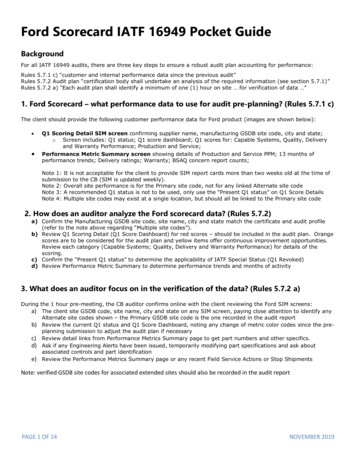
![[MS-ADTS-Diff]: Active Directory Technical Specification](/img/1/ms-adts-170316-diff.jpg)